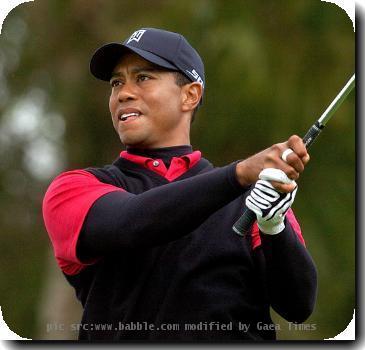Reception still the same, but reverence for Woods’ records is missing
By Doug Ferguson, APTuesday, July 20, 2010
The perception of Woods depends on a putter
ST. ANDREWS, Scotland — Tiger Woods was all over the leaderboard at the British Open.
Too bad this was on a Monday.
Locals roam the Old Course all the time on the most public of major championship properties, which King David I of Scotland granted to the people of St. Andrews way back in 1123. But some of them did more than walk their dogs in the late evening and early morning hours after Louis Oosthuizen won the British Open.
The letters and numbers on the scoreboard along the 13th hole were rearranged to show someone named Rob Rixon at 9 under. He was joined on the board with Tiger Woods, who was listed at 99 over.
Even more telling of the respect the world’s No. 1 player gets these days was the large yellow-and-blue scoreboard atop the grandstand to the left of the 18th fairway. Most of the letters were still in place for the annual message, “Well played Louis.” But instead of “See you at Sandwich in 2011″ for the next Open, it read “Shaggy Woods.”
Woods was expecting a warm reception at the home of golf, where he had won the claret jug the past two times, and there were no surprises. It’s been that way for the last few months. Aside from the tentative applause when he first showed his face to fans on a golf course that Monday at Augusta National, he still gets the biggest gallery and loudest cheers.
Gone is the reverence — as a person and a player.
The biggest change might be the perception of Woods, and it goes beyond what anyone puts on a scoreboard.
Woods’ record victory at St. Andrews a decade ago is legendary for the fact he did not play out of a single bunker in 72 holes when he won at 19-under par for an eight-stroke victory. It matched the largest margin in the Open since golf’s oldest major championship went to 72 holes at the turn of last century.
But when Oosthuizen rolled in an 18-foot birdie putt on the 12th hole Sunday — and Paul Casey lost his way through the gorse — the South African was at 17-under par and had an eight-shot lead with six holes still to play, including the par-5 14th with the wind behind him and a closing hole where old men (Tom Lehman) were capable of driving the green and making eagle.
Oosthuizen smartly played it safe the rest of the way, even treating the 17th hole as a par 5. All he wanted was his name on the base of that beautiful jug, so finishing at 16-under 272 for a seven-shot win were just numbers.
As for that amazing feat of avoiding all those bunkers on the Old Course?
“Yes, I finally hit one at the back of the 14th,” Oosthuizen said Monday in mock resignation. “It was the bunker behind the green, which was a good place for me to miss.”
The day after Woods returned home, the U.S. Junior Amateur began in Michigan. Tied for the lead after the first round of qualify was Jordan Spieth, the 16-year-old from Dallas. He not only is the defending champion, the kid made a name for himself at the Byron Nelson Championship when he was on the leaderboard during the weekend and eventually finished six shots behind the winner.
Woods won an unprecedented three straight U.S. Junior Amateur titles, and his father once considered that one of his top achievements. Now you can’t help but wonder if Spieth can join Woods as the only multiple winners, or even win three in a row.
There’s still a long way to go.
And it’s easy to get caught up in the snapshot of Woods’ career instead of looking at the big picture.
He last won a major in the 2008 U.S. Open, when he had only one good leg and needed one extra day to beat Rocco Mediate at Torrey Pines. The 0-for-7 streak he is riding still doesn’t match a pair of 0-for-10s in the majors from the 1997 Masters to the 1999 PGA Championship, and from the 2002 U.S. Open to the 2005 Masters.
It’s not time to panic just yet.
Woods now has played seven tournaments without winning, the longest he has ever gone at the start of a season since turning pro. Even during his first big swing change in 1998, he won the Johnnie Walker Classic in Thailand by rallying to beat Ernie Els.
His next stop is Firestone, where last year Woods became the first player in PGA Tour history to win seven times on the same course.
Even so, there is a difference in his game.
Woods has not been a threat on the back nine of any tournament, even the Masters and U.S. Open, where he tied for fourth. There was a feeling when he opened the British Open with a 67 that it was more of an ordinary score in calm conditions — Fredrik Andersson Hed also shot a 67 that day — than the start of something special.
And that’s where he is right now. There is nothing special about him except a record from the past.
And while it sounds overly simple, it’s all a matter of putting. Whether it was a sign of desperation or that he’s thinking too much, Woods switched putters for the first time since 1999 the first three rounds of the British Open. Worse yet is that he switched back for the final round, and perhaps it’s just a coincidence that he led the field in putting Sunday with 27 putts.
Think back to that 66 he shot at Pebble Beach in the third round to give himself a chance. The 3-wood around the tree and onto the green on the 18th was his most memorable shot of the year, but what made it so was making a couple of tough birdie putts on the two holes preceding that.
“Maybe,” Woods said after his final round Sunday, “I should go back to spraying it all over the lot and making everything.”
Golf is full of players who hit the ball long, relatively straight and shoot something around 70. And that’s where Woods is right now. He is no different from anyone else.
Tags: British Open Golf, Europe, Events, Masters Golf Tournament, Men's Golf, North America, Scotland, St. Andrews, Tiger Woods, United Kingdom, United States, Western Europe

